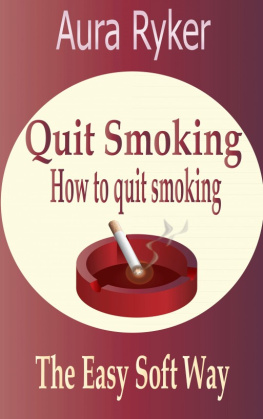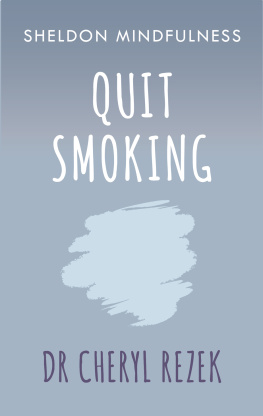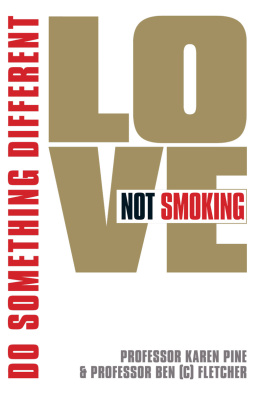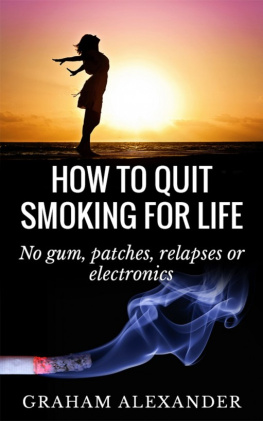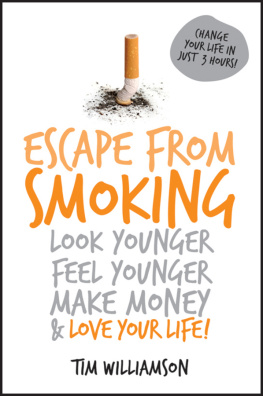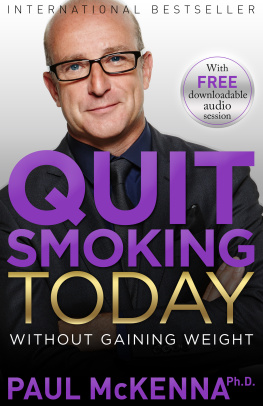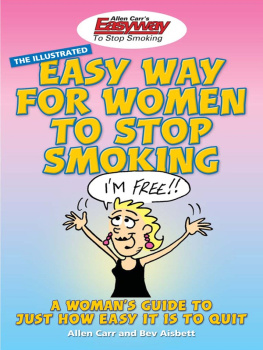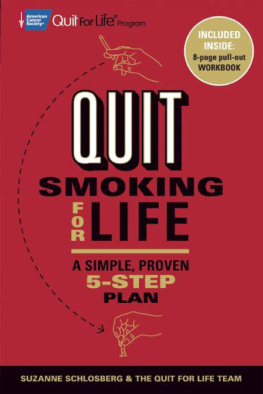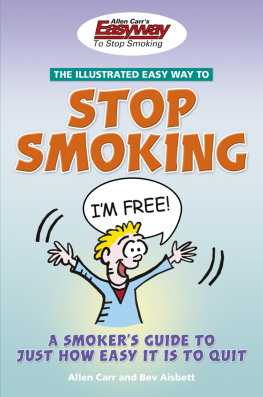QUIT SMOKING
How to Quit Smoking
The Fast and Easy way
by Aura Ryker
Copyright 2014 AuraRyker
Smashwords Edition
Table of Contents
You smoke for EmotionalReasons
You smoke to identify to a Group andValues
To manage stress andemotions
You smoke out of Fear
Chapter Tree: The solution
The TechniquePrinciple
When using this tool?
The Sequences
Bravo, Be Proud of You!
Last Thought
About the author
By the Same Author
Connect with us
BONUS:Free Hypnosis Mp3 Included!
Download your Free Quit Smoking HypnosisNow!!

Congratulation
Congratulation, stop smoking is the bestthing and decision you can make to improve your health and yourquality of life. The no-smoker have a much less high risk ofdeveloping dozens diseases, as the lung cancer, the diseases of theheart, the emphysema and the bronchitis chronicles.
The effects of tobacco on the health and thequality of life are still too often underestimated and must bereminded to make aware to the smokers of the risks they take and intheir circle of acquaintances.
This program is designed to help youthroughout your decision, covers all the emotional aspects relatedto the problems of tobacco, reveals the key to make your withdrawalfrom tobacco sure and fast, reduce and eliminate all the stressthat you oblige to light a cigarette.
This tool has been tested and works withastonishing rapidity. Your progress is fast without losing yourtime, or hopes, thanks to the emotional facts that exactly matchyour smoking behavior.
Chapter One: How Smoking Affects yourBody
The Smoking Addiction
The addiction to smoking is a drug addiction whichraises at present a big problem in health service because of thedangers that represent the constituents of the tobacco as well forthe smoker as for his circle of acquaintances. Tobacco is one of the most widely abusedsubstances in the world. It is highly addictive, even though nearly70 percent of smokers want to quit!
Nicotine is one of thousands of chemicalsin cigarettes. It's addictive and causes most of the withdrawalsymptoms you feel when you first stop. This is the physical part ofthe smoking addiction.When you use tobacco products, nicotine is quickly absorbed intoyour bloodstream. Within 10 seconds of entering your body, thenicotine reaches your brain. It causes the brain to releaseadrenaline, creating a buzz of pleasure and energy.
But this buzz fades quickly though, andleaves you feeling tired, a little down, and wanting again. Thisfeeling is what makes you light up the next cigarette. Since your body is able tobuild up a high tolerance to nicotine, youll need to smoke moreand more cigarettes in order to get the nicotines pleasurableeffects and prevent withdrawal symptoms.
Nicotine addiction is also a physicaldependency. Withdrawal symptoms are severe and most smokers cannotquit on their first attempt because of these symptoms. The most severe withdrawalsymptoms occur within the first week although the craving forcigarettes usually persists for months and even years. The desireto smoke tends to be especially strong when a person is understress. The typical withdrawal symptoms are:
Painful headaches
Anxiety and irritability
Difficult concentration
Sleeping disorder
Hunger
Decreased heart rate
Blood pressure
Nicotine craving
The most common reason given for quittingsmoking is our future personal health. Other reasons for quitting were life-stylechanges cost of cigarettes, having a baby, and smoke-relatedillness or death of a friend or family member.
The most common reason current smokersgive for not quitting is lack of will-power. This up and down cycle repeats over andover, leading to addiction. Addiction keeps people smoking evenwhen they want to quit. Breaking addiction is harder for somepeople than others. Many people need more than one try in order toquit. They need a powerful and effective technique, with provenresults, that resolve all emotional issue, and associations thatyour brain is trapped in.
Smoking harms nearly every organ in the body,including the heart, blood vessels, lungs, eyes, mouth,reproductive organs, bones, bladder, and digestive organs. Focuswill be on the most dangerous damages can smoking affect yourbody.
Smoking destroys your Lung
Smoking destroyed the natural system of cleaning and repair of yourlungs and traps the chemicals which cause the cancer.
When the natural system of cleaning andrepair of your lungs is damaged, germs, the dust and the chemicalsof the smoke of cigarette stay in your lungs. You become at risk ofdeveloping a chronic cough, an infection of the breast, the lungcancer and the COPD (Chronic Obstructive Pulmonary Disease)
Smoking damages in permanent way alveoli(bags of air) lungs.
Alveoli, small bags of air at the end oflungs, are conceived as of very small elasticated balloons. Whenyou inspire, alveoli help your body to absorb the oxygen and, whenyou expire, to get rid of some carbon dioxide.
When Smoking damages your lungs, alveoli loseof their elasticity. Your lungs have more difficulty absorbing theoxygen and getting rid of the dioxide of carbon. When alveoli areso damaged, you can feel breathlessness and a fatigue. Your hearthas to work more to distribute oxygen that your body needs. Intime, these damages can lead to the COPD and to cardiacdiseases.
Smoking hurts your heart
Most people know that cigarette and tobacco smoking increases therisk of lung cancer and breathing problems, but few realize that italso greatly increases the risk of heart disease, peripheralvascular disease.
Smoking tobacco is the strongest risk factorfor developing heart disease.
In fact, the risk of having a heart attack issix times higher in smokers, for both men and women, than in peoplewho never smoked. World-wide, smoking is thought to account foralmost 40% of first heart attacks.
Research has shown that smoking increasesheart rate, tightens major arteries, and can cause an irregularheart rhythm, all of which make your heart work harder. Smokingalso raises blood pressure, which increases the risk of stroke inpeople who already have high blood pressure.
The monoxide of carbon decreases the bloodcontribution in oxygen pulling in the long run, incapacity of theheart to work normally.
The chemicals in tobacco harm your bloodcells. They also can damage the function of your heart and thestructure and function of your blood vessels. This damage increasesyour risk of atherosclerosis, the coronary thrombosis, a hurt ofthe heart by obstruction of the coronary arteries.
Tobacco products contain chemicals thatirritate the blood vessel walls, increasing inflammation, damagingand "stiffening" the vessel walls, all conditions that areassociated with atherosclerosis.
Smoking increases adrenaline levels, whichraises the blood pressure and cardiac stress, causing constrictionof blood vessels.
One of the best ways to reduce your risk ofheart disease is to avoid tobacco smoke. No matter how much or howlong you've smoked, quitting will benefit you.
Quitting smoking will reduce your risk ofdeveloping and dying from heart disease. Over time, quitting alsowill lower your risk of atherosclerosis and blood clots. If yousmoke and already have heart disease, quitting smoking will reduceyour risk of sudden cardiac death, a second heart attack, and deathfrom other chronic diseases.

